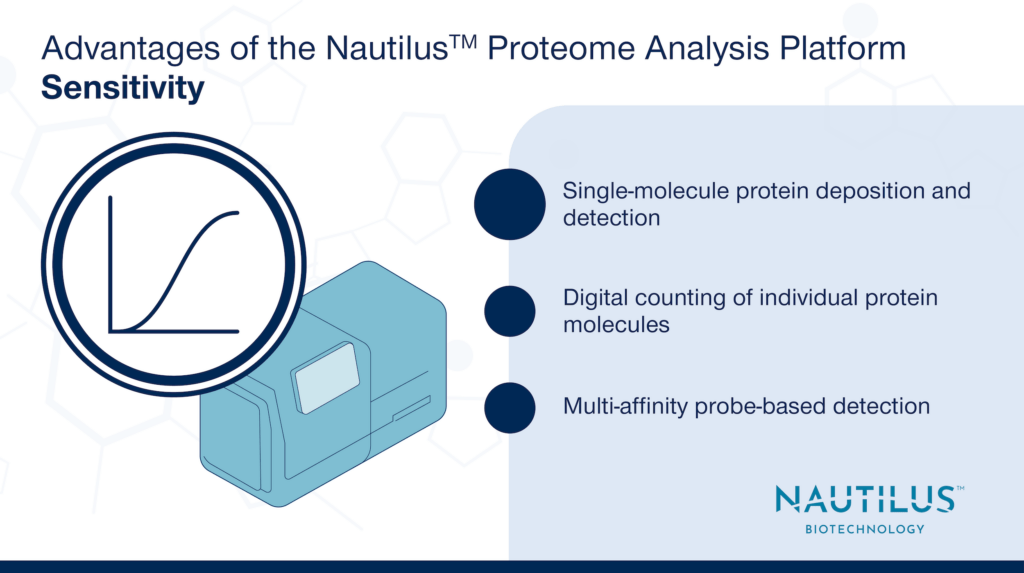
Advantages of the Nautilus Proteome Analysis Platform – Sensitivity

Tyler Ford
January 25, 2024

One of the greatest issues researchers face in discovery proteomics experiments is the lack of sensitivity inherent to traditional proteomics platforms. On these platforms, it is very difficult to detect low abundance proteins like transcription factors and signaling proteins that have outsized impacts on cellular function and phenotype. Part of the reason for this lack of sensitivity is that traditional technologies cannot detect signals coming from single molecules. The NautilusTM Proteome Analysis Platform, on the other hand, is designed with single-molecule sensitivity as a key attribute. It is expected to be able to detect both the rarest proteins and the most abundant proteins while precisely quantifying both. Below we describe some of key characteristics that give the Nautilus Platform its single-molecule sensitivity.
Key characteristics designed to give the NautilusTM Platform single-molecule sensitivity
Single-molecule protein deposition and detection
We’ve developed techniques to scaffold individual protein molecules to DNA nanoparticles and deposit the protein-scaffold conjugates on individually distinguishable landing pads on 10-billion land pad arrays. The scaffolds give the conjugates a relatively uniform size. This ensures that only single proteins can fit on each landing pad and enables the platform to detect multi-affinity probe binding events at each and every individual protein molecule. In other words, single-molecule resolution makes the platform definitionally as sensitive as it can be.
Learn how we count single protein molecules on the Nautilus Platform
Digital counting of individual protein molecules
On our platform, a single protein molecule is detected at each given landing pad. This enables us to count the number of times a protein is detected without the need for a threshold signal above background. While many other platforms measure bulk signals that must be translated into protein abundance, our platform is far more sensitive because detection = quantification.
Learn more about digital proteomics.
Multi-affinity probe-based detection
On many affinity-reagent based proteomics platforms, the individual reagents are designed to bind to single protein species. While these reagents may have high specificity, any off-target binding or aberrant non-binding events, which will occur with some probability, will lead to protein mis-identifications that increase error and lower sensitivity. On the Nautilus Platform, we use multi-affinity probes that bind to short peptide epitopes shared across many proteins. It takes many multi-affinity probe binding events to identify a protein, and the platform does not rely on any single probe for identification. With most proteins identified in 20 binding events or less and more than 30 binding events usually occurring, the likelihood of misidentification is decreased and sensitivity increased compared to other platforms.
Learn how we characterize our multi-affinity probes at Nautilus
Benefits of single-molecule sensitivity
Rare proteins have incredibly important roles to play in biology. Transcription factors can direct cellular differentiation patterns and yet are often found at low levels. Cytokines control the growth and activity of immune cells but are some of the least abundant proteins in plasma. These and other rare proteins can be difficult to detect using traditional proteomics platforms. By designing the Nautilus Proteome Analysis Platform with single-molecule sensitivity, we hope to give researchers unprecedented views into the depths of the proteome that will enable them to elucidate the complex biology driven by rare and common proteins alike.
MORE ARTICLES
